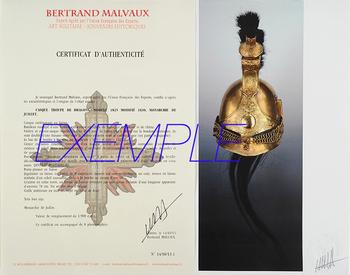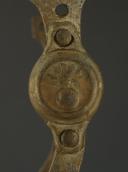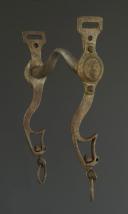
RIFLE BRIDLE BIT, Restoration. 5817
Sold out
RIFLE BRIDLE BIT, Restoration. 5817
Bridle bit
The mouth of the bit is of the so-called “pigeon-throated” shape. The barrels are almost straight, from the bottom of the pins to the heels, to provide better support on the bars.
Bit branches
The length of each branch of the bit, from the upper end above the eye to below the gargoyle, is 17 cm.
The eye of the banquet
The opening of the banquet or branch eye is 2.4 cm by 7 mm in width. A hole will be drilled 6 mm below the eye of the banquet to place the S and the hook.
A second hole is drilled below the latter to receive the copper nail intended to fix the bosses on the jacks.
Branches
Below the gargoyle, the branches are strong and straight, contained by two drums and linked together by a straight bar. The coils of this chain pass through a hole made to contain them at the rear end of the gargoyle.
Bit Gargoyle
The lower end, or the bottom of the branch, ends with an opening in the shape of an upside-down heart with rounded edges, usually called “the gargoyle”. She must help to buckle the rein holders when their rings are broken. The underside of the gargoyle is drilled with a hole intended to receive the rein holder reels fitted with their rings. Below the cannons, the branch is pierced by a hole intended to receive the nail of the lower ear of the bossette.
Bit mouthpiece
The sides of the mouth are dark in the branches of the banquet, left strong to the branches, by flat and cold riveted sinks. The arches of the banquets join exactly the roundness of the canons of the mouth to consolidate it and reinforce the branches.
The width of the mouth of the bit is 12.5 cm, measured inside the branches, from one groove to the other; the diameter of the canons of this mouth, measured at the pits, is 1.85 cm.
Branches
Below the gargoyle, the branches are strong and straight, contained by two drums and linked together by a straight bar. The coils of this chain pass through a hole made to contain them at the rear end of the gargoyle.
Bit Gargoyle
The lower end, or bottom of the branch, ends with an opening in the shape of an upside-down heart with rounded edges, usually called “the gargoyle”. She must help to buckle the rein holders when their rings are broken. The underside of the gargoyle is drilled with a hole intended to receive the rein holder reels fitted with their rings. Below the cannons, the branch is pierced by a hole intended to receive the nail of the lower ear of the bossette.
Bit mouthpiece
The sides of the mouth are dark in the branches of the banquet, left strong to the branches, by flat and cold riveted sinks. The arches of the banquets join exactly the roundness of the canons of the mouth to consolidate it and reinforce the branches.
The width of the mouth of the bit is 12.5 cm, measured inside the branches, from one groove to the other; the diameter of the canons of this mouth, measured at the pits, is 1.85 cm.
Bossettes
The bosses are made of brass; they are used to hide the pits and are an ornament. They have two ears pierced with a hole to nail them to the branches with two copper nails. The head of these nails is rounded; the point is riveted in the dimple of the funcaux, for the nail of the upper ear, and on the internal face of the branch, for the nail of the lower ear. From one end of one ear to the other, the bump is 5.7 cm long and 3.4 cm wide. The bossette is smooth stamped in its center with a bright bomb.
Entirely in filed wrought iron (originally tin-plated).
France.
Restoration.
Very good condition, surface oxidation to be cleaned.
Note :
This bit has a slight variation: the reels fixed to the lower end of the gargoyles are not vertically but horizontally.
ORIGIN :
Former Hippolyte Marie-Joseph Boivin collection (Guermantes, September 8, 1857, Bouvresse June 19, 1912).
This scholar from the end of the 19th century constitutes a collection of patriotic earthenware of great importance, having been exhibited several times in French museums.
With a collector's temperament, Hippolyte Boivin brings together earthenware from Rouen, Marseille, Strasbourg, Delft, Nevers, watches with enameled dials from the First Empire, old members, cabinets and clocks from Normandy and Picardy, chests and clocks from various periods, tapestries, rattles from all over France and even abroad.
His grandson says that H. Boivin and his wife moved from village to village, buying all the objects that seemed of some interest to them. These acquisitions enriched his own collections and those of the Beauvais museum, of which he was curator from 1889 to 1912. In this collecting business, he was also passionate about military souvenirs, mainly headdresses, copperwork, bridle bits and various souvenirs. historical.
He had a gallery built in his garden to house his military collections which would later be presented in the “Boivin room” of the Dejean barracks (Amiens), destroyed during the Second World War. Hippolyte Boivin demonstrates his predilection for patriotic earthenware by reproducing the pieces he collected through drawing and watercolor. Two reasons can explain this attraction: firstly the exile of his family of Champagne origin during the German invasion of 1870 may have given him a taste for patriotic and military objects; then, the profession of his maternal grandfather, operating a stoneware pottery factory in La Chapelle-aux-Pots, may have encouraged his attraction to ceramics.
The objects constituting the collection of this enlightened amateur were therefore all purchased according to the opportunities encountered in the “field”, which is moreover given the period of collection: from the fall of Napoleon III and until the eve of the Great War, their homogeneity was particularly preserved.
Bridle bit
The mouth of the bit is of the so-called “pigeon-throated” shape. The barrels are almost straight, from the bottom of the pins to the heels, to provide better support on the bars.
Bit branches
The length of each branch of the bit, from the upper end above the eye to below the gargoyle, is 17 cm.
The eye of the banquet
The opening of the banquet or branch eye is 2.4 cm by 7 mm in width. A hole will be drilled 6 mm below the eye of the banquet to place the S and the hook.
A second hole is drilled below the latter to receive the copper nail intended to fix the bosses on the jacks.
Branches
Below the gargoyle, the branches are strong and straight, contained by two drums and linked together by a straight bar. The coils of this chain pass through a hole made to contain them at the rear end of the gargoyle.
Bit Gargoyle
The lower end, or the bottom of the branch, ends with an opening in the shape of an upside-down heart with rounded edges, usually called “the gargoyle”. She must help to buckle the rein holders when their rings are broken. The underside of the gargoyle is drilled with a hole intended to receive the rein holder reels fitted with their rings. Below the cannons, the branch is pierced by a hole intended to receive the nail of the lower ear of the bossette.
Bit mouthpiece
The sides of the mouth are dark in the branches of the banquet, left strong to the branches, by flat and cold riveted sinks. The arches of the banquets join exactly the roundness of the canons of the mouth to consolidate it and reinforce the branches.
The width of the mouth of the bit is 12.5 cm, measured inside the branches, from one groove to the other; the diameter of the canons of this mouth, measured at the pits, is 1.85 cm.
Branches
Below the gargoyle, the branches are strong and straight, contained by two drums and linked together by a straight bar. The coils of this chain pass through a hole made to contain them at the rear end of the gargoyle.
Bit Gargoyle
The lower end, or bottom of the branch, ends with an opening in the shape of an upside-down heart with rounded edges, usually called “the gargoyle”. She must help to buckle the rein holders when their rings are broken. The underside of the gargoyle is drilled with a hole intended to receive the rein holder reels fitted with their rings. Below the cannons, the branch is pierced by a hole intended to receive the nail of the lower ear of the bossette.
Bit mouthpiece
The sides of the mouth are dark in the branches of the banquet, left strong to the branches, by flat and cold riveted sinks. The arches of the banquets join exactly the roundness of the canons of the mouth to consolidate it and reinforce the branches.
The width of the mouth of the bit is 12.5 cm, measured inside the branches, from one groove to the other; the diameter of the canons of this mouth, measured at the pits, is 1.85 cm.
Bossettes
The bosses are made of brass; they are used to hide the pits and are an ornament. They have two ears pierced with a hole to nail them to the branches with two copper nails. The head of these nails is rounded; the point is riveted in the dimple of the funcaux, for the nail of the upper ear, and on the internal face of the branch, for the nail of the lower ear. From one end of one ear to the other, the bump is 5.7 cm long and 3.4 cm wide. The bossette is smooth stamped in its center with a bright bomb.
Entirely in filed wrought iron (originally tin-plated).
France.
Restoration.
Very good condition, surface oxidation to be cleaned.
Note :
This bit has a slight variation: the reels fixed to the lower end of the gargoyles are not vertically but horizontally.
ORIGIN :
Former Hippolyte Marie-Joseph Boivin collection (Guermantes, September 8, 1857, Bouvresse June 19, 1912).
This scholar from the end of the 19th century constitutes a collection of patriotic earthenware of great importance, having been exhibited several times in French museums.
With a collector's temperament, Hippolyte Boivin brings together earthenware from Rouen, Marseille, Strasbourg, Delft, Nevers, watches with enameled dials from the First Empire, old members, cabinets and clocks from Normandy and Picardy, chests and clocks from various periods, tapestries, rattles from all over France and even abroad.
His grandson says that H. Boivin and his wife moved from village to village, buying all the objects that seemed of some interest to them. These acquisitions enriched his own collections and those of the Beauvais museum, of which he was curator from 1889 to 1912. In this collecting business, he was also passionate about military souvenirs, mainly headdresses, copperwork, bridle bits and various souvenirs. historical.
He had a gallery built in his garden to house his military collections which would later be presented in the “Boivin room” of the Dejean barracks (Amiens), destroyed during the Second World War. Hippolyte Boivin demonstrates his predilection for patriotic earthenware by reproducing the pieces he collected through drawing and watercolor. Two reasons can explain this attraction: firstly the exile of his family of Champagne origin during the German invasion of 1870 may have given him a taste for patriotic and military objects; then, the profession of his maternal grandfather, operating a stoneware pottery factory in La Chapelle-aux-Pots, may have encouraged his attraction to ceramics.
The objects constituting the collection of this enlightened amateur were therefore all purchased according to the opportunities encountered in the “field”, which is moreover given the period of collection: from the fall of Napoleon III and until the eve of the Great War, their homogeneity was particularly preserved.
Reference :
5817

Next update Friday, april 18th at 13:30 PM
FOR ALL PURCHASES, PAYMENT IN MULTIPLE CHECKS POSSIBLE
bertrand.malvaux@wanadoo.fr 06 07 75 74 63
An authenticity certificate of the item including the description published on the site, the period, the sale price, accompanied by one or more color photographs is automatically provided for any item priced over 130 euros. Below this price, each certificate is charged 5 euros.
Only items sold by me are subject to an authenticity certificate, I do not provide any expert reports for items sold by third parties (colleagues or collectors).


